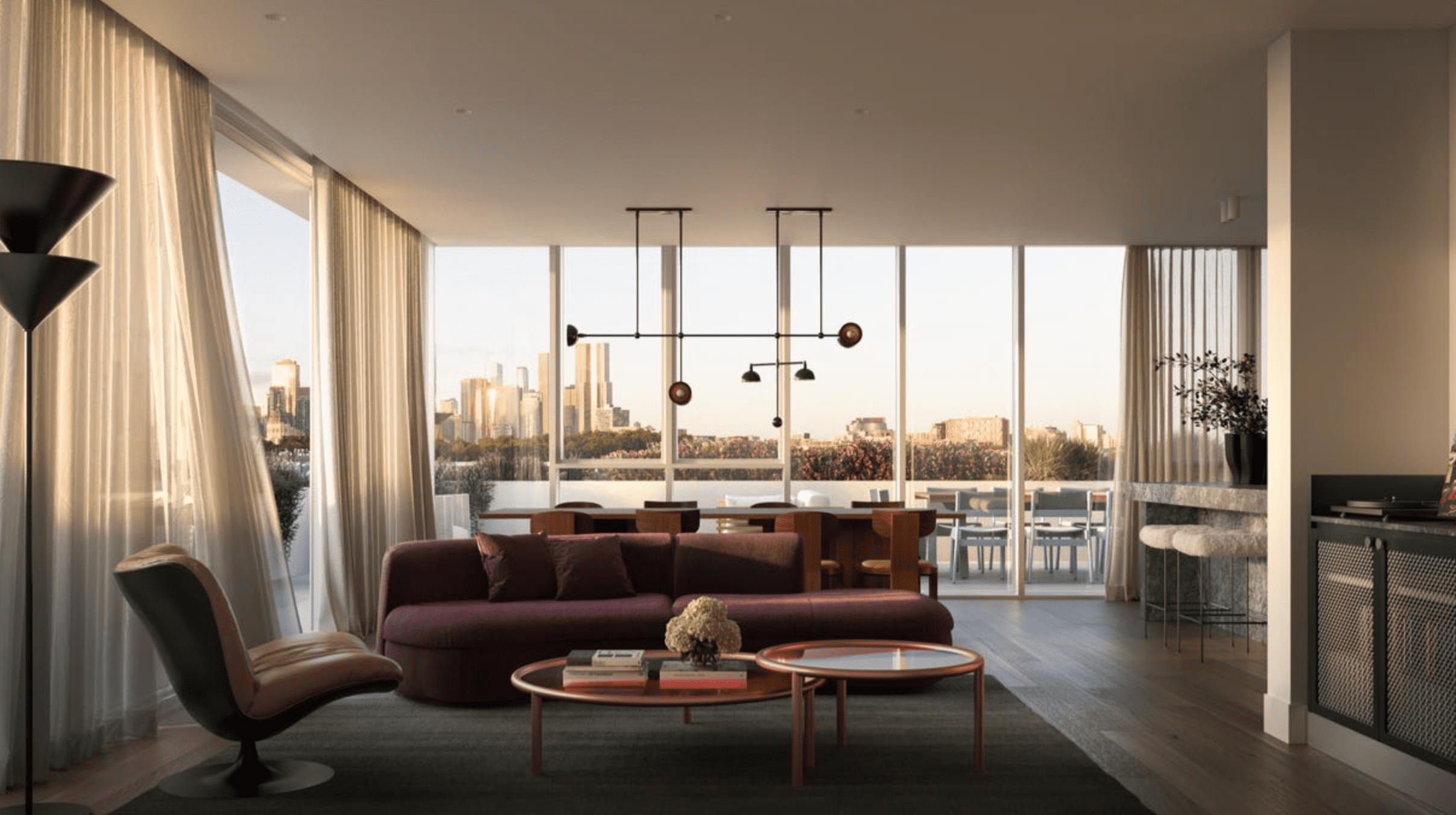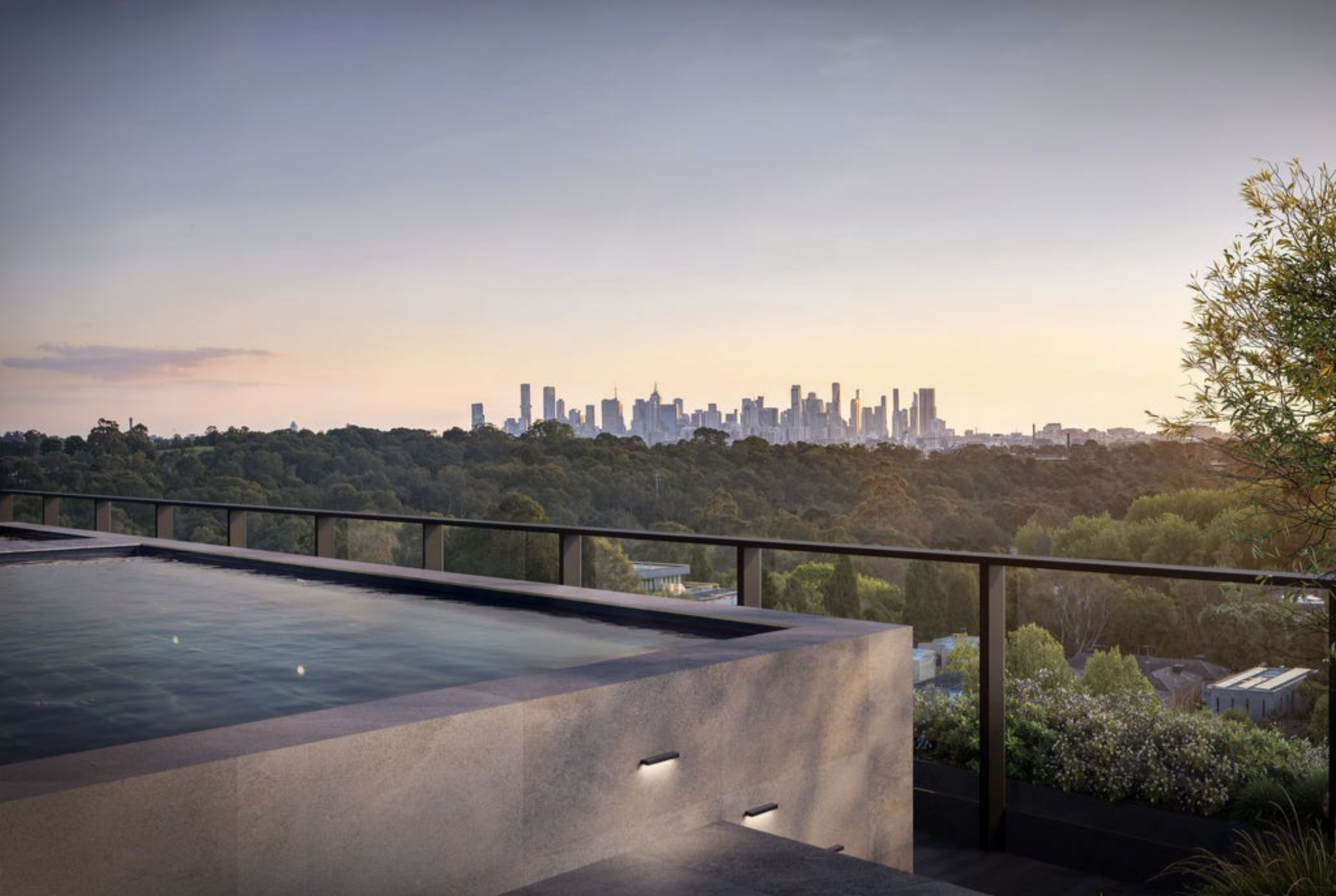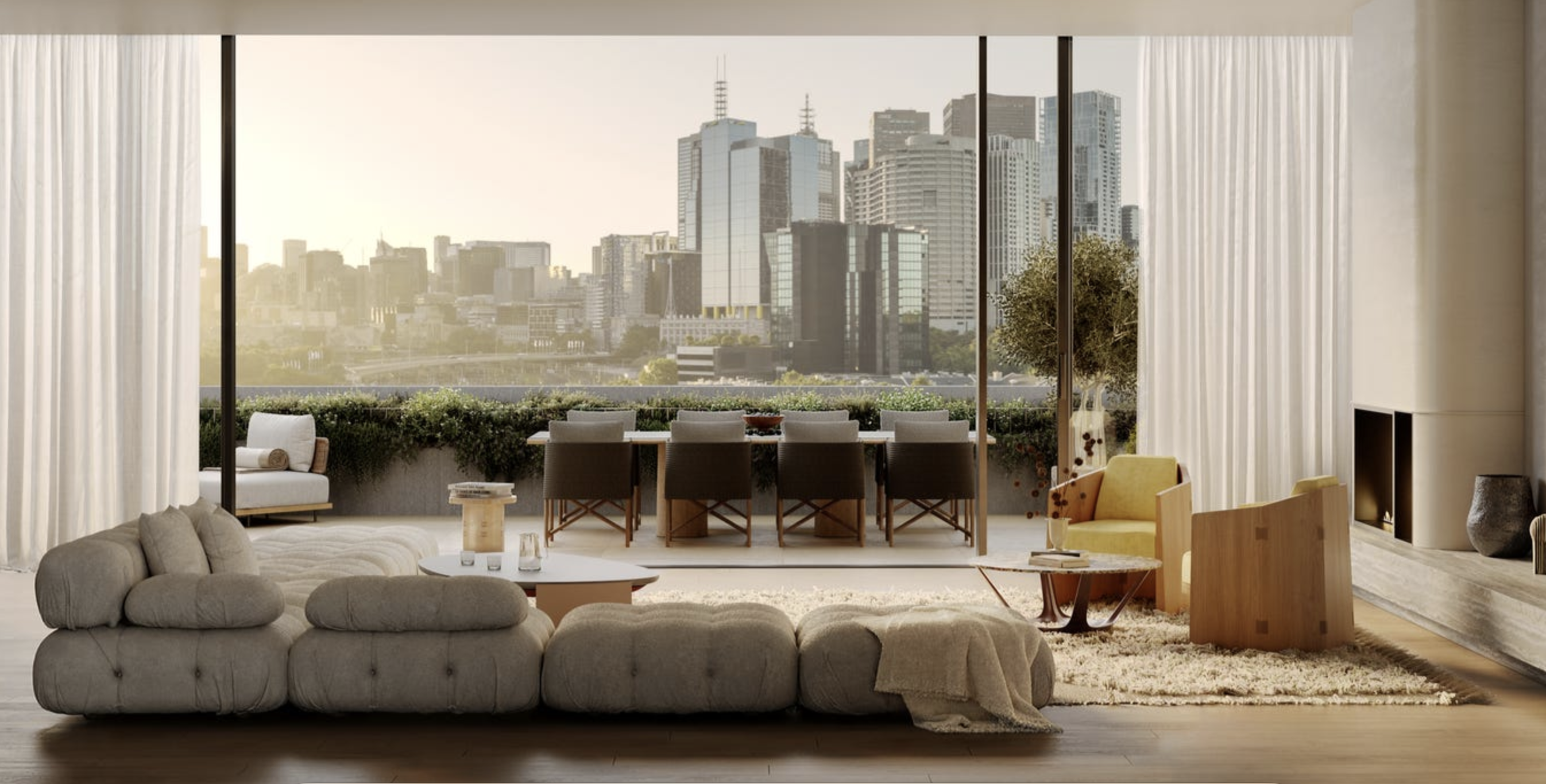Melbourne’s top five new penthouses to buy in 2025
Penthouses are smashing suburb records across Melbourne. From South Yarra to Alphington, these five new sky-high homes lead the luxury pack in 2025.
Penthouses have long represented the pinnacle of luxury living, but in Melbourne’s most sought-after inner suburbs, they’re now also setting suburb records—sometimes surpassing the price of standalone houses.
One recent sale in Fitzroy saw a penthouse atop the under-construction Fitzroy development change hands for $10 million, with an additional $3.5 million to be spent on the fitout—a new benchmark for the area.
It was the same story in Camberwell, where the penthouse crowning Victoria Hill by Time & Place sold off the plan for more than $15 million, another suburb record.
While Melbourne’s skyline remains more restrained than Sydney’s, its penthouses are growing more ambitious in scale and design. Most crown boutique developments are between 10 and 20 storeys high, taking advantage of uninterrupted views and prime, walkable locations.
Developers are pushing the boundaries of height and amenity, with rooftop pools, private lifts, sculptural interiors, and expansive outdoor spaces becoming the norm at the high end.
From South Yarra’s $19.5 million Art Deco-inspired showpiece to a heritage-blending super penthouse in Alphington and a rare full-floor offering in East Melbourne, we’ve rounded up the top five new penthouse apartments currently on the market in 2025.
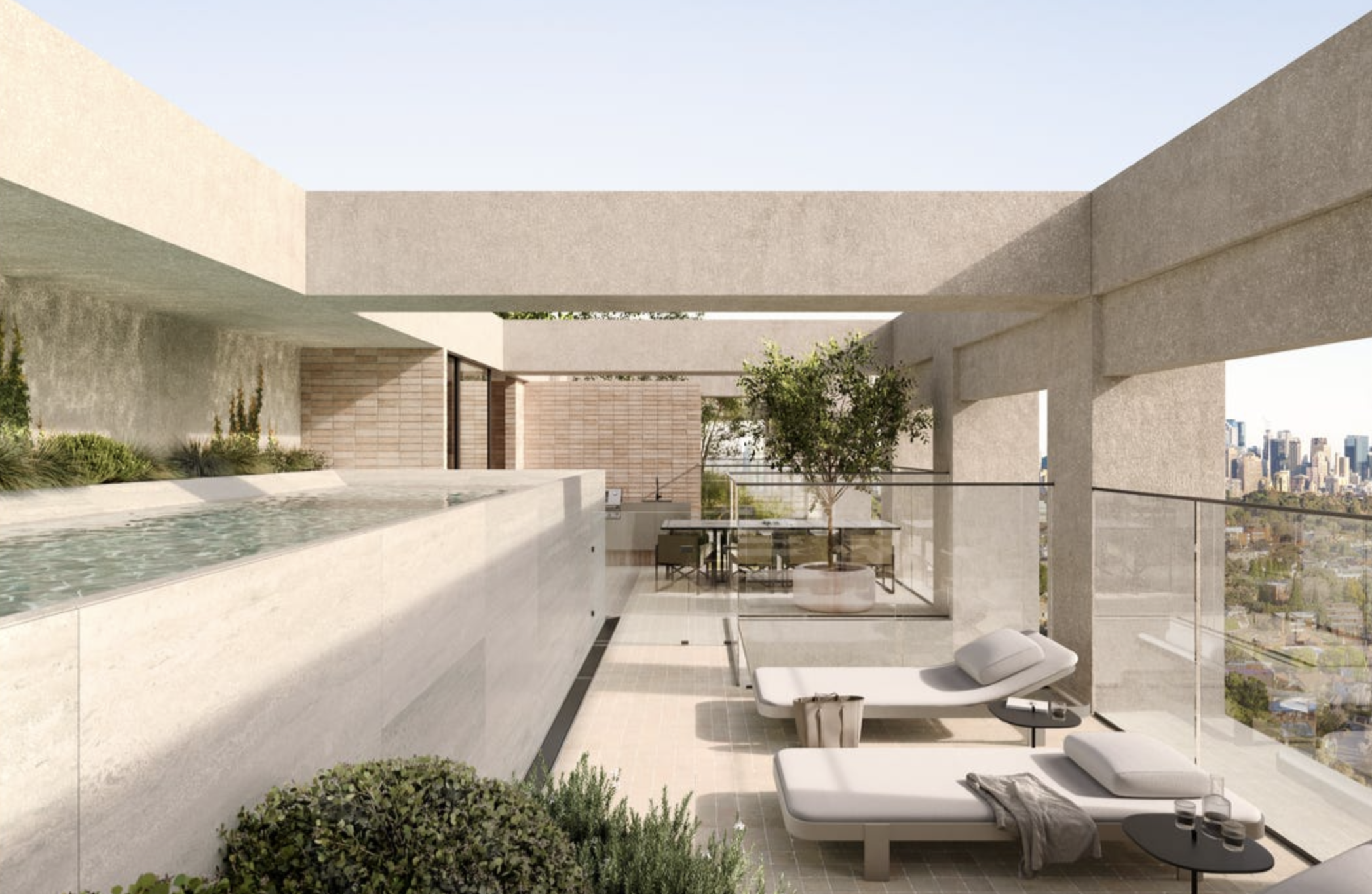
South Yarra House, South Yarra
One of the priciest new penthouses on the market can be found in South Yarra, one of Melbourne’s premier suburbs. Joint venture partners Wattletree and Dorman Capital are asking $19.5 million for the penthouse of its under-construction new development, South Yarra House.
The two-level, full-floor penthouse, with interiors by Hecker Guthrie, will have four bedrooms, one of which is a master suite pitched as “one of the most luxurious spaces in Melbourne.” It will come with a walk-in wardrobe, an ensuite with a sculpted marble bath and natural stone floor and wall tiles, and a private terrace with north-west facing views of the city.
There will be a glass-wrapped rooftop terrace, on the 20th-level of the building, which will feature an alfresco and outdoor kitchen, and a raised lap pool.
South Yarra House has been designed by SJB Architects to reflect South Yarra’s rich Art Deco history.
“South Yarra House takes subtle cues from its surrounds, and the heritage buildings dotted throughout, and blends it with a modernist sensibility to create an outcome of clarity, elegance and distinction,” SJB said.
The building will have just 58 two-, three-, and four–bedroom apartments. Renowned construction firm Hickory is building South Yarra House.
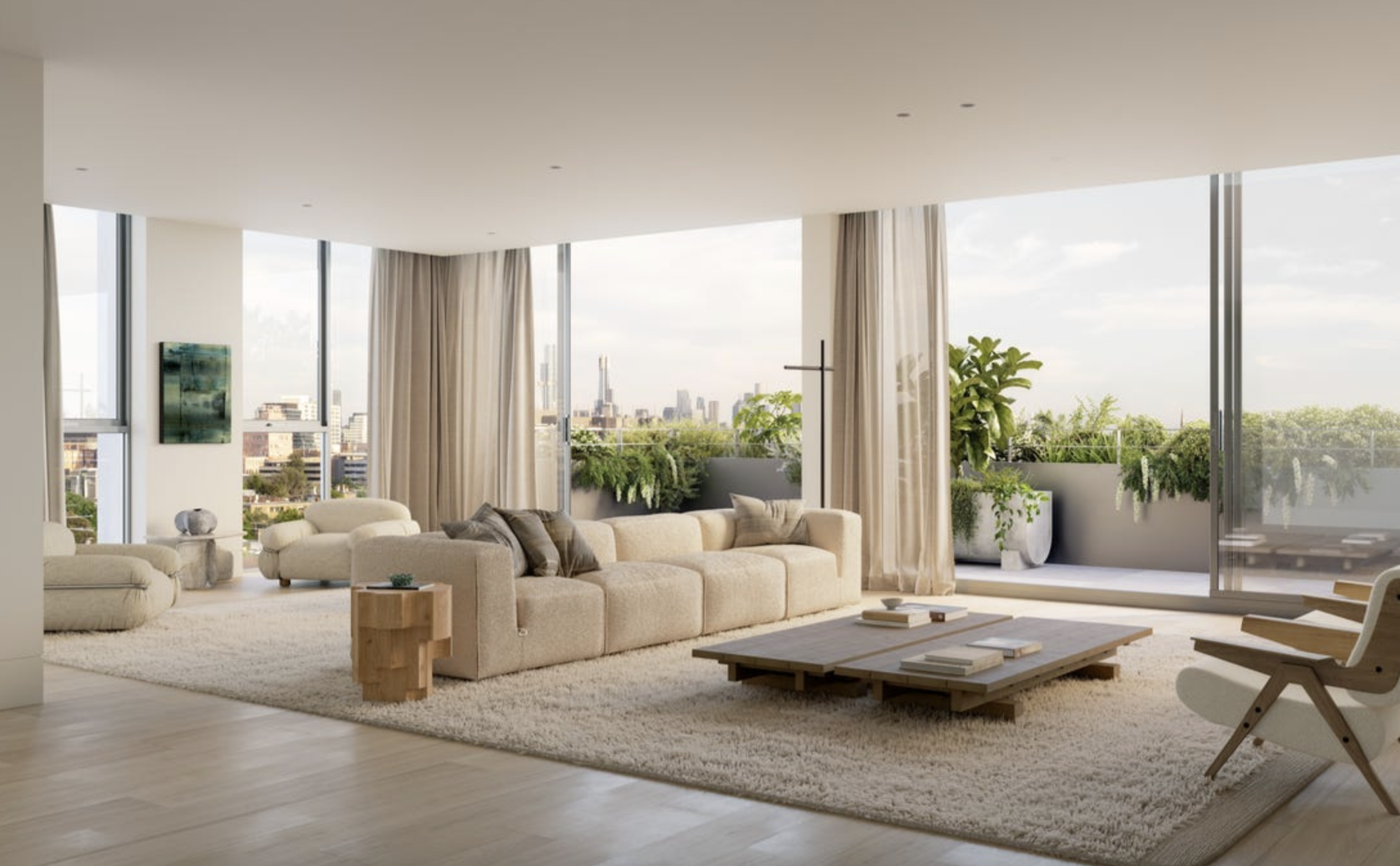
One Charles, Prahran
Another special penthouse by SJB and Hecker Guthrie is coming to Melbourne’s neighbouring Prahran. They’ve been the architects behind One Charles, a new apartment project being developed by Monde near Prahran Station.
Another full-floor apartment, north-facing, will have soaring three-metre-high ceilings, four bedrooms, a private study, and a large 355 sqm wrap-around terrace.
The interiors feature a sculptural stone kitchen with Gaggenau appliances and a butler’s pantry, while there’s a secure garage, not for one, but four cars.
The penthouse is priced at $12.5 million. One Charles will comprise 28 two and three-bedroom apartments, walking distance to Greville Street, Chapel Street, and the Prahran Market.
The Regent, Fitzroy
Unlike its neighbouring suburbs, Fitzroy rarely sees full-floor penthouse apartments hit the market, which makes the recently released penthouse by SMA Projects even more special.
The four-bedroom penthouse atop their new development The Regent Fitzroy, will offer sweeping views from every one of its rooms. It will have four bedrooms and two living areas, designed by Studio Tate for multi-generational living.
The main living area will be wrapped in a terrace, with enough space for several lounge and alfresco areas, and an outdoor barbecue kitchen.
Hayball has designed the new building, which pays homage to The Regent Theatre, which used to occupy the Fitzroy Street site before it burned down in 1984.
It will feature 69 one-, two-, three-, and four-bedroom apartments, along with shared spaces that include a communal rooftop terrace with barbecue facilities, a bookable overnight guest suite for visiting friends and family, and both a dedicated ground-floor concierge and a digital concierge.
Seren Row, Alphington
Veteran builder-developer Glenvill is selling what it calls its “Super Penthouse” at its Seren Row stage of its multistage, 16.5-hectare YarraBend masterplan.
The Super Penthouse, one of 12 penthouse and sub-penthouses within the historic grounds of the former Australian Paper Mill in Alphington, has been designed by Fraser & Partners to blend heritage character with refined contemporary living. The 416 sqm apartment will have four bedrooms, four bathrooms, a separate home office, a multi-purpose room, and a private rooftop with a pool, spa, and outdoor kitchen. It will have finishes in travertine, quartzite, and herringbone timber.
Residents of the Seren Row penthouse collection will also gain exclusive access to the Signature Club, a next-level suite of amenities including a subterranean wellness centre onsen, gym, sauna and steam rooms, golf simulator, co-working spaces, and even a monthly cleaning and chauffeur service. They will also have access to The Hub—a co-working and social space—plus The Bend, a dining precinct curated by acclaimed chef Adam D’Sylva.
Dyason, East Melbourne
Nearly $12 million is being sought for the penthouse atop Dyason, the new East Melbourne apartment development by Valli. The two-level, four-bedroom penthouse, with direct private elevator access, has been designed by Pandolfini Architects in collaboration with interiors by Lisa Buxton and landscaping by Acre.
The clever design creates a 14.5-metre-long living area that captures extensive views from the MCG to the CBD. Sunrise will flood the eastern kitchen with light, and sunsets will cast a glow over the open fireplace. The kitchen features a Sub-Zero fridge, Wolf ovens, a 400-bottle wine cellar, and an integrated bar. There will be two outdoor terraces on each level.
Dyason, on East Melbourne’s dress circle Jolimont Street, will have just five apartments and a heritage home, which will be restored and converted into a townhouse.
Records keep falling in 2025 as harbourfront, beachfront and blue-chip estates crowd the top of the market.
A divide has opened in the tech job market between those with artificial-intelligence skills and everyone else.
The 2026 McGrath Report warns that without urgent reforms to planning, infrastructure and construction, housing affordability will continue to slip beyond reach for most Australians.
Australia’s housing market has reached a critical juncture, with home ownership and rental affordability deteriorating to their worst levels in decades, according to the McGrath Report 2026.
The annual analysis from real estate entrepreneur John McGrath paints a sobering picture of a nation where even the “lucky country” has run out of luck — or at least, out of homes.
New borrowers are now spending half their household income servicing loans, while renters are devoting one-third of their earnings to rent.
The time needed to save a 20 per cent deposit has stretched beyond ten years, and the home price-to-income ratio has climbed to eight times. “These aren’t just statistics,” McGrath writes. “They represent real people and real pain.”
McGrath argues that the root cause of Australia’s housing crisis is not a shortage of land, but a shortage of accessibility and deliverable stock.
“Over half our population has squeezed into just three cities, creating price pressure and rising density in Sydney, Melbourne and Brisbane while vast developable land sits disconnected from essential infrastructure,” he says.
The report identifies three faltering pillars — supply, affordability and construction viability — as the drivers of instability in the current market.
Developers across the country, McGrath notes, are “unable to make the numbers work” due to labour shortages and soaring construction costs.
In many trades, shortages have doubled or tripled, and build costs have surged by more than 30 per cent, stalling thousands of projects.
Need for systemic reform
McGrath’s prescription is clear: the only real solution lies in increasing supply through systemic reform. “We need to streamline development processes, reduce approval timeframes and provide better infrastructure to free up the options and provide more choice for everyone on where they live,” he says.
The 2026 edition of the report also points to promising trends in policy and innovation. Across several states, governments are prioritising higher-density development near transport hubs and repurposing government-owned land with existing infrastructure.
Build-to-rent models are expanding, and planning reforms are gaining traction. McGrath notes that while these steps are encouraging, they must be accelerated and supported by new construction methods if Australia is to meet demand.
One of the report’s key opportunities lies in prefabrication and modular design. “Prefabricated homes can be completed in 10–12 weeks compared to 18 months for a traditional house, saving time and money for everyone involved,” McGrath says.
The report suggests that modular and 3D-printed housing could play a significant role in addressing shortages while setting a new global benchmark for speed, cost and quality in residential construction.
Intelligent homes
In a section titled Weathering the Future: The Power of Smart Design, the report emphasises that sustainable and intelligent home design is no longer aspirational but essential.
It highlights new technologies that reduce energy use, improve thermal efficiency, and make homes more resilient to climate risks.
“There’s no reason why Australia shouldn’t be a world leader in innovative design and construction — and many reasons why we should be,” McGrath writes.
Despite the challenges, the tone of the 2026 McGrath Report is one of cautious optimism. Demand is expected to stabilise at around 175,000 households per year from 2026, and construction cost growth is finally slowing. Governments are also showing a greater willingness to reform outdated planning frameworks.
McGrath concludes that the path forward requires bold decisions and collaboration between all levels of government and industry.
“Australia has the land, demand and capability,” he says. “What we need now is the will to implement supply-focused solutions that address root causes rather than symptoms.”
“Only then,” he adds, “can we turn the dream of home ownership back into something more than a dream.”
A luxury lifestyle might cost more than it used to, but how does it compare with cities around the world?
On October 2, acclaimed chef Dan Arnold will host an exclusive evening, unveiling a Michelin-inspired menu in a rare masterclass of food, storytelling and flavour.









